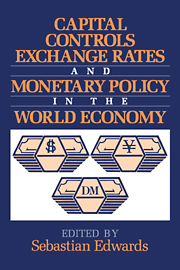Book contents
- Frontmatter
- Contents
- List of contributors
- Introduction
- Part I Monetary policy and stabilization in open economies
- Part II Capital mobility and macroeconomic policy in Europe
- Part III Capital controls and macroeconomic policy in the Asia-Pacific region
- Part IV Capital mobility and exchange rates in Latin America
- Index
Introduction
Published online by Cambridge University Press: 16 October 2009
- Frontmatter
- Contents
- List of contributors
- Introduction
- Part I Monetary policy and stabilization in open economies
- Part II Capital mobility and macroeconomic policy in Europe
- Part III Capital controls and macroeconomic policy in the Asia-Pacific region
- Part IV Capital mobility and exchange rates in Latin America
- Index
Summary
The past few years have seen a remarkable expansion in international trade. Throughout the globe countries have liberalized their trade accounts, reducing import tariffs and eliminating quantitative restrictions. What is perhaps most remarkable about this process is that, after years of hesitation, many developing nations have joined the more advanced countries in implementing trade liberalization reforms. For example, during the late 1980s and early 1990s most of the Latin American nations, which since the 1930s had favored an import substitution development strategy, went through gigantic unilateral trade reforms. Similar processes are taking place in Asia, where countries that for decades had pursued highly protectionist policies – India, for instance – are implementing major trade liberalization efforts. There is little doubt that, as we enter the end of the century, the view that freer trade and liberalization is conducive to improved economic performance has become dominant in academic as well as in policy circles. The decades-old debate between outward orientation and inward orientation has been decisively won by the proponents of more open commercial policies. The approval of GATT's Uruguay Round in December of 1993 has added impetus to the global efforts to open international trade.
Although impediments to international trade in goods and (to some extent) services have been greatly reduced, restrctions on capital movements continue to be widespread, especially among the newly industrialized and developing nations.
- Type
- Chapter
- Information
- Publisher: Cambridge University PressPrint publication year: 1995
- 2
- Cited by



